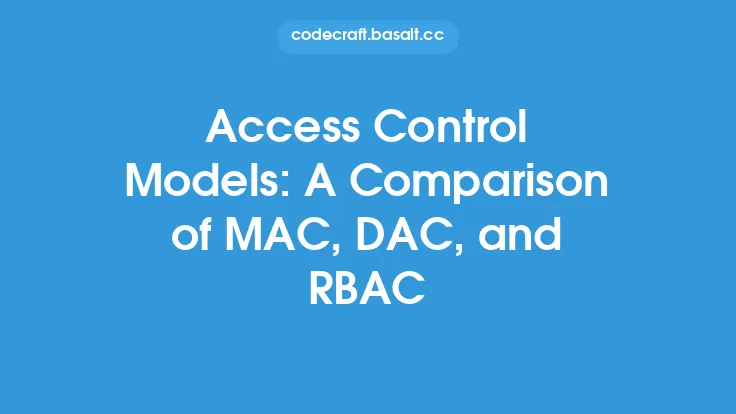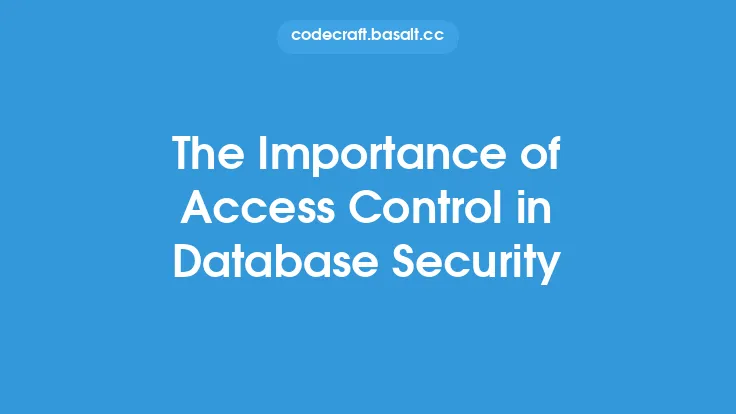Discretionary Access Control (DAC) is a type of access control model that grants or denies access to resources based on the discretion of the owner of the resource. In this model, the owner of the resource has the authority to decide who can access the resource and what actions they can perform on it. DAC is a widely used access control model in operating systems, databases, and other computer systems.
Introduction to Discretionary Access Control
DAC is based on the concept of ownership, where the owner of a resource has complete control over it. The owner can grant or deny access to the resource to other users or groups, and can also specify the level of access that each user or group has. For example, in a file system, the owner of a file can grant read, write, or execute access to other users or groups. DAC is often used in conjunction with other access control models, such as Mandatory Access Control (MAC) and Role-Based Access Control (RBAC), to provide a more comprehensive access control system.
Key Components of Discretionary Access Control
There are several key components of DAC, including:
- Owner: The owner of a resource is the user or group that has complete control over the resource. The owner can grant or deny access to the resource to other users or groups.
- Access Control List (ACL): An ACL is a list of users or groups that have been granted access to a resource, along with the level of access that each user or group has. ACLs are used to implement DAC in many operating systems and databases.
- Permissions: Permissions are the levels of access that can be granted to a user or group. Common permissions include read, write, execute, and delete.
- Inheritance: Inheritance is the process by which a child object inherits the permissions of its parent object. For example, in a file system, a subdirectory may inherit the permissions of its parent directory.
How Discretionary Access Control Works
DAC works by granting or denying access to resources based on the discretion of the owner. When a user requests access to a resource, the system checks the ACL to determine if the user has been granted access. If the user has been granted access, the system checks the permissions to determine what actions the user can perform on the resource. If the user does not have permission to perform a certain action, the system denies access.
Advantages of Discretionary Access Control
DAC has several advantages, including:
- Flexibility: DAC provides a high degree of flexibility, as the owner of a resource can grant or deny access to other users or groups as needed.
- Ease of use: DAC is relatively easy to use, as the owner of a resource can simply grant or deny access to other users or groups without having to worry about complex rules or policies.
- Fine-grained control: DAC provides fine-grained control over access to resources, as the owner can specify exactly what actions each user or group can perform on the resource.
Disadvantages of Discretionary Access Control
DAC also has several disadvantages, including:
- Security risks: DAC can pose security risks if the owner of a resource grants access to unauthorized users or groups.
- Complexity: While DAC is relatively easy to use, it can become complex to manage in large systems with many users and resources.
- Lack of scalability: DAC can be difficult to scale in large systems, as the number of ACLs and permissions can become unwieldy.
Real-World Applications of Discretionary Access Control
DAC is widely used in many real-world applications, including:
- Operating systems: DAC is used in many operating systems, including Windows, Linux, and macOS, to control access to files, directories, and other resources.
- Databases: DAC is used in many databases, including relational databases and NoSQL databases, to control access to data and other resources.
- File systems: DAC is used in many file systems, including network file systems and cloud storage systems, to control access to files and directories.
Best Practices for Implementing Discretionary Access Control
To implement DAC effectively, several best practices should be followed, including:
- Use strong permissions: Use strong permissions, such as read-only or execute-only, to limit the actions that users can perform on resources.
- Use groups: Use groups to simplify the management of ACLs and permissions.
- Monitor and audit: Monitor and audit access to resources to detect and respond to security incidents.
- Use inheritance: Use inheritance to simplify the management of permissions and ACLs.
Conclusion
Discretionary Access Control is a widely used access control model that grants or denies access to resources based on the discretion of the owner. While DAC has several advantages, including flexibility and ease of use, it also has several disadvantages, including security risks and complexity. By following best practices and using DAC in conjunction with other access control models, organizations can implement a comprehensive access control system that protects their resources from unauthorized access.





